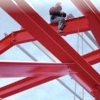The settlement addresses the Jan. 6, 2005, Norfolk Southern train derailment in Graniteville, S.C., that resulted in the death of nine people from chlorine exposure, hundreds of people seeking medical care due to respiratory distress, and the evacuation of more than 5,000 people living and working within a 1-mile radius of the release area.
The new guidance does away with the old Survey Type 1, 2, and 3, replacing those with the more comprehensive Management Survey and Refurbishment and Demolition Survey.
A commentary published this month in Toxicological Sciences, the Society of Toxicology's journal, says the latest research "closes the door" on claims the chemical is an environmental hazard of concern.
An inspection found workers unable to open emergency exit doors from inside the workplace; a lack of specific procedures to lock out machine power sources; missing guardrails; improperly stored oxygen cylinders; several electrical hazards; and more.

The March 4 "OSHA Listens" meeting did not lack for out-of-the-box thinking. What OSHA does with the input from ASSE President Chris Patton and others is the crucial part, of course.
Among the products considered most likely to lead to the danger of an explosion or fire are zinc and other metallic powders, wheat flour and other food products, and certain plastics and resins. In all of these cases, if unprotected, normal processing steps can produce enough static electricity to ignite a dust cloud.
"OSHA standards are designed to minimize the risk of exposure and its potential impact on workers' health, but they are effective only so long as employers adhere to them," said Brenda Gordon, OSHA's area director for Boston and southeastern Massachusetts.
The four-year Hazardcheck campaign unveiled on March 1 builds on the Government of Canada's Chemicals Management Plan and Clean Air Agenda.
Specifically, the agency found instances of improper transfer and storage of flammable liquids; lack of specific lockout/tagout procedures and training to prevent the unintended startup of machines during maintenance; lack of hearing protection; inadequate respirator training, fit-testing, medical evaluation, inspection, and maintenance; unguarded grinders; and more.

Exposure to hand and arm vibration in the workplace can range from severe and debilitating to nuisance level. Fortunately, there are simple solutions to this under-reported, under-regulated problem.
According to the government's lawsuit, the tax preparers allegedly sold interests in the fictive facilities to thousands of customers in at least 14 states across the country and prepared income tax returns for customers claiming tax credits based on the concocted methane sales.

Former ACOEM President Dr. Robert McCunney, on a panel assembled by the American Wind Energy Association to review the published literature on possible health effects caused by today's wind turbines, said the experts found no risk at all.
"This facility has not experienced an injury resulting in lost time in the last four years," noted Richard S. Terrill, OSHA's regional administrator. "Their outstanding efforts have included significant management commitment and employee involvement."

Design professionals are seeing the $8 billion investment the Obama administration is making in high-speed rail as a major impulse for new market niches.
"Out of sight does not mean out of mind when it comes to underground petroleum storage tanks, and it is critical that facilities monitor their tanks and make sure they are not leaking," said EPA Regional Administrator Judith Enck.

Four years of meetings and dialogue among partner agencies have created a network that will move ahead on EU-wide research, if funding support is maintained.
The agency's revised "current intelligence bulletin" for asbestos fibers and other elongate mineral particles explains what NIOSH still wants to explore and also clarifies the 1990 NIOSH recommended exposure limit for airborne asbestos fibers.
Specifically, OSHA found blocked exits, workers lacking safety glasses and gloves while working with acid, unlabeled containers of hazardous chemicals, unmarked electrical equipment, exposed live electrical parts, and moisture in electrical equipment.
The willful violations cited address the inappropriate location of an air material separator that lacked explosion venting, an inadequate housekeeping program, and allowing combustible dusts to collect at depths greater than one-eighth of an inch.
"Our honorees will be diverse. They won’t all be public figures, well known, or famous; they will be everyday heroes making a difference in the lives of others,” said ASSE WISE Chair Kelly Bernish.